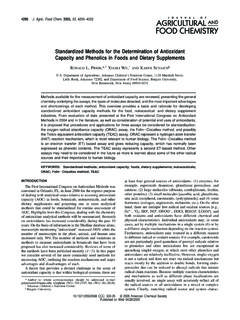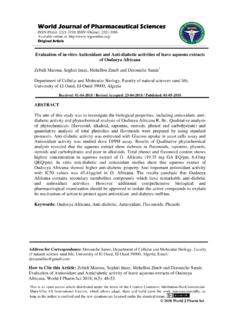Transcription of Journal of Photochemistry and Photobiology B: Biology
1 Journal of Photochemistry and Photobiology B: Biology 136 (2014) 12 18. Contents lists available at ScienceDirect Journal of Photochemistry and Photobiology B: Biology Journal homepage: Protective effects of citrus and rosemary extracts on UV-induced damage in skin cell model and human volunteers A. P rez-S nchez a,1, E. Barraj n-Catal n a,1, N. Caturla b, J. Castillo c,e, O. Benavente-Garc a c,e, M. Alcaraz d,e, V. Micol a, . a Skin Research Platform (SRP), Instituto de Biolog a Molecular y Celular (IBMC), Universidad Miguel Hern ndez, Avenida de la Universidad s/n, E-03202 Elche, Alicante, Spain b Monteloeder , Miguel Servet 16, nave 17, 03203 Elche, Alicante, Spain c Nutrafur , Camino Viejo de Pliego, , 30820 Alcantarilla, Murcia, Spain d Radiology and Physical Medicine Department, Faculty of Medicine, University of Murcia, 30100 Espinardo, Murcia, Spain e Institute of Research Into Aging, University of Murcia, 30100 Espinardo, Murcia, Spain a r t i c l e i n f o a b s t r a c t Article history: Ultraviolet radiation absorbed by the epidermis is the major cause of various cutaneous disorders, includ- Received 24 February 2014 ing photoaging and skin cancers.
2 Although topical sunscreens may offer proper skin protection, dietary Received in revised form 5 April 2014 plant compounds may signi cantly contribute to lifelong protection of skin health, especially when Accepted 7 April 2014. unconsciously sun UV exposed. A combination of rosemary and citrus bio avonoids extracts was used Available online 20 April 2014. to inhibit UV harmful effects on human HaCaT keratinocytes and in human volunteers after oral intake. Survival of HaCaT cells after UVB radiation was higher in treatments using the combination of extracts Keywords: than in those performed with individual extracts, indicating potential synergic effects. The combination UV radiation Oral photoprotection of extracts also decreased UVB-induced intracellular radical oxygen species (ROS) and prevented DNA. ROS damage in HaCaT cells by comet assay and decreased chromosomal aberrations in X-irradiated human DNA damage lymphocytes.
3 The oral daily consumption of 250 mg of the combination by human volunteers revealed Rosemary a signi cant minimal erythema dose (MED) increase after eight weeks (34%, p < ). Stronger protection Citrus was achieved after 12 weeks (56%, p < ). The combination of citrus avonoids and rosemary polyphe- Polyphenols nols and diterpenes may be considered as an ingredient for oral photoprotection. Their mechanism of action may deserve further attention. 2014 Elsevier All rights reserved. 1. Introduction Both UVA and UVB contribute signi cantly to photoaging. Photo- aging is the superposition of chronic UV-induced damage on intrin- UV radiation from the sun induces several harmful responses, sic skin aging and accounts for most age-related changes in skin including erythema, immunosuppression, edema, sunburn, hyper- appearance [4]. The molecular mechanism of photoaging is mostly plasia, hyperpigmentation, premature aging and skin cancer.
4 Only triggered by ROS-mediated activation of cell surface receptors lead- UVA (320 400 nm) and UVB (280 320 nm) are harmful to our ing to stimulation of stress-associated kinase pathways, which are skin. UVA accounts for more than 90% of the total UV radiation mediated by protein 1 (AP-1) nuclear transcription factor [5]. This reaching us and is constant throughout the year, but UVB photons factor prompts prostaglandin release, keratinocyte proliferation are one thousand times more capable of causing sunburn than UVA and a loss of collagen synthesis [6]. ROS also lead to the activation and increase considerably in the summer [1]. UVA is thought to of NF-jB transcription factor, which induces the expression of pro- play a crucial role in photoaging and causes epidermal hyperplasia, in ammatory cytokines and metaloproteinases (MMPs). Finally, stratum corneum thickening and the synthesis of in ammatory ROS-induced mitochondrial DNA deletions compromise mitochon- cytokines and metalloproteinases (MMPs) [2,3].
5 Meanwhile, UVB drial function [4]. All these factors together with direct protein oxi- causes sunburn, sun tanning, pigmented spots and wrinkles and dation contribute to accelerate extracellular matrix degradation. accelerates skin aging. Although UVA is suspected to play a major role in photoaging, UVB activates AP-1 and causes direct DNA damage, in ammation, immunosuppression, angiogenesis and elastin degradation. Corresponding author. Tel.: +34 96 6658430; fax: +34 96 6658758. Major protective systems in human skin cells are the natural E-mail address: (V. Micol). 1. pigment melanin, which absorbs and scatters UV radiation, and These authors have contributed equally. 1011-1344/ 2014 Elsevier All rights reserved. A. P rez-S nchez et al. / Journal of Photochemistry and Photobiology B: Biology 136 (2014) 12 18 13. skin cells' antioxidant enzymes (catalase, superoxide dismutase Keratinocyte cell culture and glutathione peroxidase) [4].
6 Moreover, p53 protein plays a cru- cial role in UVB protection, acting as a transcription factor that con- HaCaT cells were grown in DMEM with 10% (v/v) FBS and 1% (v/v). trols genes involved in the cell cycle, apoptosis and DNA repair [7]. penicillin streptomycin ( mg/ml penicillin and 100 U/ml Human skin is inadvertently exposed to approximately 2/3 of the streptomycin) in a humidi ed atmosphere with CO2 (5% v/v) at cumulative erythemal ultraviolet (UV) dose/year when no topical 37 C. The HaCaT cells were trypsinized every third day, following protection is used [8]. Therefore, beyond topical sunscreen protec- the manufacturer's instructions, and seeded in 96- or six-well plates, tion when consciously exposed [9], photoprotection by dietary depending on the assay. compounds via endogenous delivery to the skin may signi cantly contribute to lifelong protection of skin health.
7 Several plant phyto- Treatment of cells, UVB irradiation and MTT survival assay chemicals have been found to be effective in preventing UV-induced DNA oxidative damage through a ROS scavenging mechanism Cells were cultured in 96-well plates and maintained in med- in vitro and in animal models [1]. Rosmarinic acid [10 12], a pheno- ium for 24 h. For treatments, cells at 50 70% con uence were lic acid derivative, the iso avone genistein [13] and silibin from washed with phosphate-buffered saline (PBS) and treated with milk thistle [14] have exhibited skin protective effects against PBS containing the selected extract ( 100 lg/ml, no toxicity UVB-induced ROS on mice and cell models through p53 activation was observed at these concentrations), followed by treatment with and decreased DNA damage. Chrysin (5,7-dihydroxy avone) atten- UVB light emitted from a Bio-Link Crosslinker BLX-E312 (Vilber uates apoptosis, ROS generation and cyclooxygenase 2 (COX-2) Lourmat, France) at 800 or 1200 J/m2 [20].
8 Afterward, the PBS. expression and diminishes aquaporin-3 downregulation induced was replaced with fresh medium, and the cells were incubated by UVB and UVA [15]. Rosemary diterpenes display strong in vitro for 72 h for viability assays or for 2 h for comet or ROS assays. antioxidant and anti-in ammatory effects, together with in vivo The MTT assay was used for determining cellular viability [21]. skin protective effects [16 18], and forskolin protects keratinocytes The cell protection level was calculated as the percentage of cell from UVB-induced apoptosis independently of melanin content viability recovered under a certain condition, where 100% was [19]. the difference between non-irradiated cells and irradiated cells in In the present study, a speci c combination of a rosemary the absence of the extract. extract, enriched in polyphenols and diterpenes, and a citrus bio - avonoid extract, containing avonoids, was used for the rst time to Total phenolic content determination inhibit UVB's harmful effects on human keratinocytes.
9 The capacity of this combination to decrease UVB-mediated cell death, ROS for- Total polyphenolic content was determined using the Folin . mation and DNA damage in human keratinocytes, and genotoxicity Ciocalteu method, using gallic acid as the standard [22,23]. induced by X-rays in human lymphocytes, was assessed. A human intervention study using 250 mg of this combination by oral admin- ROS generation evaluation istration for three months was also established to determine the capacity of the ingredient to increase the minimal erythema dose 20 ,70 -Dichlorodihydro uorescein diacetate (H2 DCFDA) (Molecu- (MED) of the volunteers upon UV exposure. lar probes , Life Technologies Co., Europe) was used to monitor the intracellular ROS generation induced by UVB radiation [21]. Promptly, cells were cultured in a 96-well black plate until 90 . 2. Materials and methods 100% con uence was reached.
10 The cells were then treated with a thin layer of PBS containing the combined extract (75 100 lg/ml), Materials followed by treatment with UVB light (800 or 1200 J/m2) and labeled with H2 DCFDA. The human keratinocytes HaCaT (a spontaneously immortal- ized cell line) were obtained from CLS Cell Lines Service GmbH. Single-cell gel electrophoresis (comet assay). (Eppelheim, Germany). Dulbecco's modi ed Eagle's medium (DMEM), fetal bovine serum (FBS) and penicillin streptomycin Comet assay was essentially performed as previously reported were obtained from Gibco (Life Technologies Co., Europe). Phyto- [11]. A total of 50 nuclei by duplicate were utilized for determina- hemagglutinin, cytochalasin B (Cyt B) and the rest of the reagents tion of Comet score. The gels were analyzed by uorescence were purchased from Sigma Aldrich (Europe). microscopy (Nikon Eclipse TE2000U). DNA damage was quanti ed as described in Supplementary information section.

